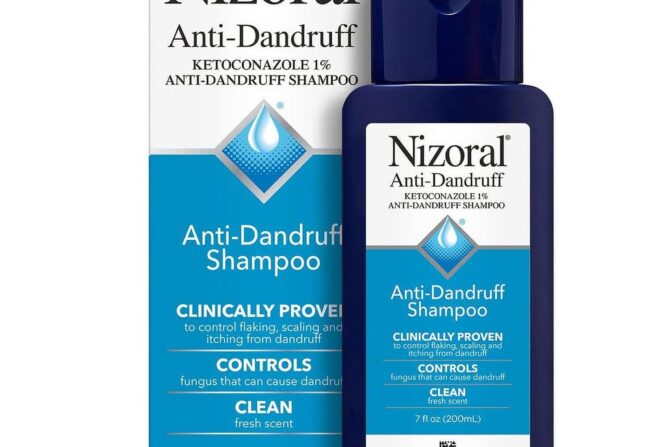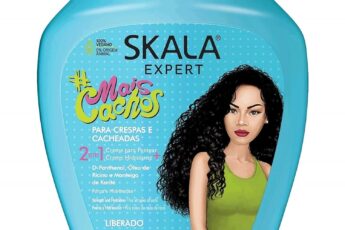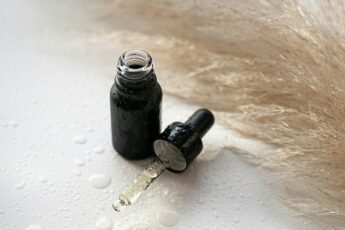Have you ever scratched your scalp in public and tried to pretend it was nothing? I have. That quiet panic when you brush your hair and tiny white flakes fall on your black top—it’s not fun. You start wondering if someone saw it. You try to dust it off quickly, hoping nobody noticed. It’s one of those little things that can make you feel self-conscious, even when you’re having a good day.
When I first heard about Nizoral Shampoo, I didn’t expect much. I’d already tried enough “anti-dandruff miracles” that promised smooth, flake-free hair but never delivered. Most just left my scalp dry and my hair dull. But Nizoral felt different from the start. It’s not just a shampoo you use because of dandruff—it’s something that actually helps your scalp heal. And once that happens, everything else starts to fall into place.
Table of Contents
Key Takeaways
- Nizoral Shampoo is clinically proven to control flaking, scaling, and itching.
- It fights dandruff at the root cause by killing the scalp fungus.
- Contains Ketoconazole 1%, a strong and proven ingredient.
- Works on all hair types, including color-treated or chemically processed hair.
- Use twice a week for the best results.
- Pair with Nizoral Deep Moisturizing Conditioner for hydration and softness.
- Conditioner is non-medicated, gentle, and free of sulfates, parabens, and dyes.
Why Dandruff Keeps Coming Back
You know that annoying thing where your scalp starts itching again a few days after you thought it was gone? That’s because most shampoos only wash away the flakes—they don’t stop what’s causing them.
Dandruff isn’t just about dry skin. There’s a little fungus behind it called Malassezia. It sounds scary, but it’s actually common. The problem starts when it grows more than it should. That’s when your scalp reacts—itching, flaking, and feeling sore. Most shampoos never reach that fungus. They just calm the surface, so the relief doesn’t last.
That’s where Nizoral Shampoo changes the game. It goes beyond washing. It targets what’s really going on beneath the surface. It doesn’t just make your scalp look better—it helps it feel better too.
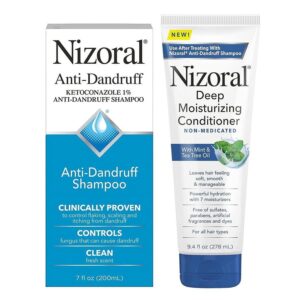
What Makes Nizoral Shampoo Different
When I looked closer at what makes Nizoral Shampoo special, the first thing that stood out was the ingredient list. It has Ketoconazole 1%—a name that sounds technical but means something simple: it kills the fungus that causes dandruff. It’s not a regular shampoo ingredient. In fact, it’s the only over-the-counter dandruff shampoo with Ketoconazole 1%.
This is why Nizoral isn’t just about the symptoms. It’s about the source. The flakes, the itching, the constant dryness—all of it starts to ease when the fungus stops growing. And when your scalp feels balanced again, your hair begins to follow.
It’s also clinically proven to control flaking, scaling, and itching. You don’t have to take anyone’s word for it. It’s backed by science, but it feels gentle, which surprised me. I expected something strong and harsh, but it left my scalp feeling calm.
And yes, it even helps with severe dandruff. So if you’ve been stuck in that cycle of “good hair week” followed by another wave of flakes, this might be what finally breaks it.
Also Read: Co-Wash vs Shampoo: The Honest Guide to Healthier, Happier Hair
How to Use Nizoral Shampoo for the Best Results
If you’re like me, you probably grab your shampoo, scrub, rinse, and move on. But Nizoral works best when you slow down a little.
Here’s what I found helpful:
- Use it twice a week, not every day.
- Wet your hair and scalp completely before applying.
- Use just enough to work up a gentle lather.
- Let it sit for a minute or two—this part really matters. It gives the Ketoconazole time to do its job.
- Rinse thoroughly.
I like to use it on Sundays and Wednesdays—it gives me a rhythm that’s easy to remember. And on other days, I use my regular shampoo.
Now, here’s the part many people miss: follow it up with Nizoral Deep Moisturizing Conditioner. After I started doing that, my hair stopped feeling dry after washes. The conditioner adds back moisture without undoing what the shampoo did.
Nizoral Deep Moisturizing Conditioner
The first time I used this conditioner, I was skeptical. I thought, “How is this any different from the ones sitting in my shower right now?” But it turned out to be one of those quiet surprises.
It’s non-medicated, which means it doesn’t mess with the Ketoconazole from the shampoo. It’s actually clinically proven not to strip away the medicine from your scalp. That’s a small detail but a big deal if you’ve been trying to get consistent results.
It’s packed with 7 moisturizers, plus mint and tea tree oil. When I first applied it, I could feel that light cooling touch from the mint—it’s subtle but refreshing. It left my hair feeling soft, smooth, and easy to manage.
And because it’s free of sulfates, parabens, artificial fragrances, and dyes, it feels gentle enough to use often. You don’t get that waxy buildup some conditioners leave behind. It just makes your hair fall naturally and feel clean.
It works for all hair types—mine is wavy and color-treated, and I’ve had no issues. A friend with tighter curls tried it too and said it didn’t weigh her hair down. So if your hair’s been through coloring, straightening, or any kind of chemical process, it’s still safe to use.
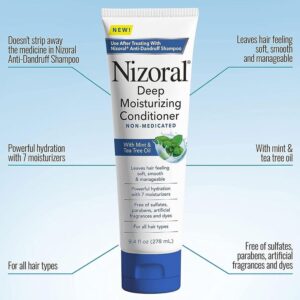
How It Feels After Washing
There’s this little moment after you rinse Nizoral out when your scalp feels quiet. Not tingly, not tight—just peaceful.
I usually wrap my hair in a towel and take a second to breathe. It’s like washing off more than just the flakes. My scalp feels light, clean, and balanced. And when I run my fingers through my hair later, it feels soft without that slippery residue some shampoos leave behind.
The scent is fresh but not overwhelming. It doesn’t smell like medicine, which is a relief. It’s the kind of smell that feels clean without trying too hard.
When I started using it regularly, I noticed I wasn’t scratching my scalp absentmindedly anymore. The itching faded, and the flakes started disappearing. It wasn’t instant, but after two weeks, my hair just looked… calmer.
Honest Thoughts from Users
I love reading what other people say before I buy something. With Nizoral Shampoo, the reviews were full of the same kind of relief I felt.
One woman mentioned how her scalp finally felt “normal” again after years of trying everything. Another said it made her hair look cleaner and even helped it grow better. I can relate to that part—when your scalp is healthy, your hair finally gets a chance to breathe.
A few people said it’s a bit pricey, and I get that. But when something actually works, it feels worth it. Dandruff can mess with your confidence in quiet ways. So finding something that gives you back that comfort feels like a small victory.
Of course, not everyone will have the same experience. Some said they prefer to use it less often because it’s strong. That’s why I always suggest starting slow—twice a week is usually enough.
Key Ingredients and What They Do
You don’t need to be a chemist to understand what’s in Nizoral. The main thing that makes it work is Ketoconazole 1%—the star of the show.
Here’s a simple breakdown of what’s inside and why it matters:
- Ketoconazole 1% – fights the fungus that causes dandruff.
- Tea Tree Oil & Mint – help soothe and refresh your scalp.
- Moisturizers (7 total) – keep your hair soft and smooth after washing.
- No Sulfates, Parabens, or Dyes – gentle enough for frequent use and all hair types.
The combination makes it strong where it needs to be and gentle where it matters.
Check Out: Hair Burst Shampoo Review: The Simple Secret to Softer, Healthier Curls
Why I Think Nizoral Shampoo Is Worth Trying
If you’ve ever felt embarrassed brushing flakes off your shoulders, you’ll understand why I love this shampoo. It’s not about vanity—it’s about comfort.
There was a time I stopped wearing dark clothes because of dandruff. I’d spend time styling my hair, only to ruin my mood when flakes showed up again. It felt endless. But Nizoral broke that cycle for me.
What I appreciate most is the sense of calm it brings. My scalp doesn’t itch. My hair feels lighter. And when I walk out, I’m not thinking about dandruff anymore. That kind of peace feels small until you lose it—then you realize how good it is to have it back.
If you’ve tried everything and nothing seems to last, I’d say give Nizoral a try. Use it patiently. Follow it with the Deep Moisturizing Conditioner. Stick with it for a few weeks. You’ll start noticing the change—not just on your scalp, but in how you feel when you touch your hair.

Conclusion
When you find something that genuinely helps your scalp feel calm again, you hold on to it. Nizoral Shampoo isn’t a quick fix—it’s a quiet helper that gives your scalp the care it’s been needing.
I think of it as a reset button. You use it, and slowly your scalp starts feeling balanced again. Your hair feels lighter, smoother, and softer. The conditioner adds that final touch of moisture, and together they just work.
If you’ve been struggling with flakes, itching, or that constant dry feeling, try it. Use it twice a week. Pair it with the Deep Moisturizing Conditioner. Give it time to show what it can do.
It might sound simple, but that calm, flake-free feeling—it’s worth it.
Frequently Asked Questions
How often should I use Nizoral Shampoo?
Use it twice a week between your regular shampoos. That’s usually enough to keep dandruff under control.
Can I use it with other hair products?
Yes. You can style your hair as usual afterward. Just make sure you rinse thoroughly so no shampoo residue stays behind.
Is it safe for color-treated hair?
Absolutely. It’s safe for color-treated, chemically processed, and even gray hair.
Does it have a strong smell?
No, the scent is mild and clean. It leaves your hair smelling fresh without being overpowering.

